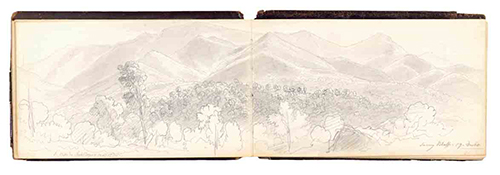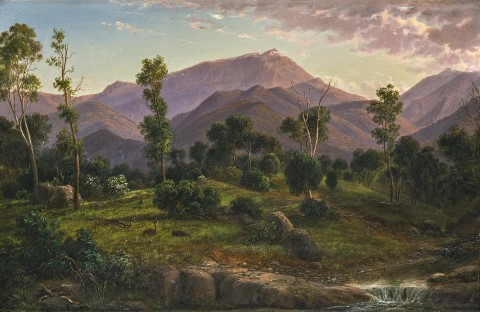MOUNT KENT, ON THE WONNANGATTA, GIPPS LAND, 1873
EUGENE VON Guérard
oil on academy board
31.0 x 47.0 cm
signed and dated lower right: E. v. Guerard / 1873
bears inscription verso: Mrs D.A. Paterson / 114 Riversdale Rd / Glenferrie
Private collection
Arthur Tuckett & Son, Melbourne, 8 May 1914, lot 98 (as ‘Mount Kent’)
Arthur Tuckett & Son, Melbourne, 3 December 1914, lot 61 (as ‘Mount Kent, Gippsland’)
Mrs D. A. Paterson, Melbourne, by 1932
Private collection, New Zealand
Private collection, acquired in 1978
Christie's, Sydney, 17 August 1999, lot 72 (as 'View of Mount Kent, Gippsland')
Private collection, New South Wales
Private collection, Sydney, acquired from the above
The Fourth Exhibition of the Victorian Academy of Arts, Melbourne, July 1874, cat. 74 (as 'Mount Kurt [sic], on the Wannangatta [sic], Gipps Land'), £20.0.0.
Loan Exhibition of Antiques in aid of The Free Kindergarten Union of Victoria, Rocke's Building, Melbourne, 19 May – 4 June 1932, cat. 1401 (as 'View of Mt. Kent, Gippsland’) (lent by Mrs D.A. Patterson)
‘Victorian Academy of Art. Fourth Exhibition’, The Argus, Melbourne, 30 July 1874, p. 6
Bruce, C., Comstock, E., & McDonald, F., Eugene von Guérard: A German Romantic in the Antipodes, Alistair Taylor, Maryborough, New Zealand, 1982, cat. 106 and cat. 151, pp. 240, 264
Pullin, R., The Artist as Traveller: The Sketchbooks of Eugene von Guerard, Art Gallery of Ballarat, Victoria, 2018, pp. 218, 220 – 221
Snowy Bluff 19 Dec 1860 and Mount Kent and Part of the Snowy Bluff, Sketchbook XXXII, 1860, folios 31 and 32, Dixson Galleries, State Library of New South Wales, Sydney, DGB16, vol. 11
In July 1874, Eugene von Guérard presented his oil painting Mount Kent, on the Wonnangatta, Gipps Land, 1873 to the people of Melbourne through the fourth exhibition of the Victorian Academy of Arts. It hung proudly with three more of his paintings in the Academy’s newly opened building on Eastern Hill. The extensive catalogue of 277 works listed their titles as ‘Pulpit Rock, Cape Schank’; ‘Mount Kurt, on the Wannangatta [sic], Gipps Land’ (our painting); ‘St. Agnes Head, north end of Phillip Island’; and ‘Gobett’s [sic] Leap and the Grose Valley, Blue Mountains, N. S.W.’. The leading colonial artists of the day were well represented – Louis Buvelot, H.J. Johnstone, Isaac Whitehead, J.H. Carse from Sydney, and John Gully from New Zealand. And landscapes predominated, The Argus review noting: ‘… a man comes to look upon the mountain and woodland scenery of Victoria with a more appreciative regard, after having been accustomed to see the most poetical aspects of both reflected from the canvas of a Guerard and a Buvelot’.1 The taste of the time was mirrored on the catalogue cover’s well-known quotation from Shakespeare: ‘Whose end, both at the first and now, was and is, to hold, as ‘twere, the mirror up to nature’.2
DH1833 Cat19NOV v1.jpg

Led to Australia in 1852 by the lure of Ballarat gold, the Victorian wilderness soon captured von Guérard’s eye and pencil. Settling in Melbourne two years later, he travelled afield to South Australia, New South Wales and Tasmania in search of the sublime and other subjects suitable. His standing as an artist rose rapidly. By 1870 he had been appointed the first Master of the School of Painting and Curator of the National Gallery of Victoria, the Gallery already having acquired two of his major paintings.
Working in the German Romantic tradition, von Guérard awed his admiring audiences with his own awe of nature. Scientific exactness and truth to nature distinguished canvas after magnificent canvas. The same was reflected in their detailed titles. While the might and majesty of nature runs throughout von Guérard’s art, his Australian works show a fascination renewed by the wonders of the antipodes. Its exotic scenery and animals were still curiosities in the eyes of the European settler and visitor alike. Freshness of vision is readily apparent in Mount Kent, on the Wonnangatta, Gipps Land, 1873. The emu peoples the land, while birds of prey startle white cockatoos in the sky. The untamed grandeur of the scene is given a dramatic touch by profiling the mountain peaks against the sky. Yet, all is enveloped in a civilising calm of enchanting beauty, so admired by his contemporaries: ‘… M. von Guerard, excels in his delineation of mountain scenery, and sunset effects or ranges clothed with primeval forests’.3
Mount Kent, on the Wonnangatta, Gipps Land had its genesis in late 1860 in drawings made during the time von Guérard was with Alfred Howitt’s government survey expedition into the mountains of Gippsland. Howitt, referring to von Guérard as ‘the celebrated Australian painter’, observed that the artist ‘is delighted with the mountain scenery – he had no idea that Australia had such country’.4 Von Guérard made two drawings related to our painting. The first, a panorama covering both pages of his sketchbook, is inscribed ‘Snowy Bluff 19 Dec 1860’. The other, ‘Mount Kent and Part of the Snowy Bluff’, is the drawing on which our painting was composed.5
von.jpg

New South Wales, 1873, oil on canvas, 68.5 x 106.4 cm, collection of
The two von Guérard paintings which evoked special praise when shown in the 1874 Victorian Academy of Arts exhibition were Govett’s Leap and Grose River Valley Blue Mountains, New South Wales, 1873 (now in the collection of the National Gallery of Australia, Canberra) and Mount Kent, on the Wonnangatta, Gipps Land, 1873. In an enthusiastic review, The Argus reported: ‘The scene [of the former] is of impressive magnitude and grandeur, and brings out the artist’s strength, which lies in the effective representation of mountain masses …’6 Our painting shows that for von Guérard grandeur also can be encompassed in works much smaller in scale. Describing the painting as ‘a charming little landscape on the Wannangatta [sic], Gipps Land’, the reviewer delighted in:
An undulating and grassy foreground, lightly timbered and embossed with massive boulders, in [sic] enlivened by a “trotting brook,” which comes sparkling down from the magnificent mountain ranges on the background. These culminate in a majestic eminence, known as Mount Kurt [sic], the peaks of which are flushed with the glow of sunset. The canvas is small, but there is a great deal compressed within its narrow limits’.7
Giving valuable insight into how von Guérard’s contemporaries thought and felt about his art, there is a perceptive suggestion that this painted image encompasses sound, especially delight in the bubbling waters.
1. ‘Victorian Academy of Arts. Fourth Exhibition’, The Argus, 30 July 1874, p. 6
2. Catalogue cover of The Fourth Exhibition of the Victorian Academy of Arts, Melbourne, 1874
3. ‘The Fine Arts in Victoria’, Australasian Sketcher, Melbourne, 5 September 1874, p. 91
4. Folios 31 and 32, Sketchbook XXXII, 1860, Dixson Galleries, State Library of New South Wales, Sydney, DGB16, vol. 11. I am grateful to Ruth Pullin for identifying these drawings.
5. Alfred Howitt, letter to his mother, Howitt papers, 1045/3a, no. 10, quoted in Pullin, op. cit., p. 214
6. ‘Victorian Academy of Arts. Fourth Exhibition’, The Argus, op. cit., 30 July 1874, p. 6
7. ibid.
DAVID THOMAS
